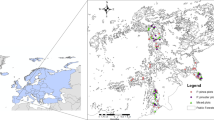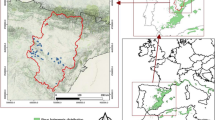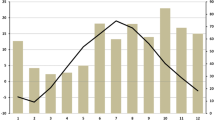Abstract
Key message
In the inner-Alpine Aosta Valley, severe growth reductions occurred in Scots pine stands during 1987–1993 and 2003–2005. Trees more sensitive to May precipitation exhibited stronger growth decline during these periods.
Abstract
Over the last decades, Scots pine (Pinus sylvestris L.) decline has involved large areas in the European Alps. Although the species is supposed to be drought resistant, increased temperatures and droughts are often indicated as predisposing causes of the decline. Nevertheless, the exact climate conditions that initiate the decline, and the reasons why they differentially affect individual trees, are largely unknown. Our aims were to identify climate constraints on Scots pine growth, and elucidate the effect of individual characteristics, such as tree age, size, crown condition, mistletoe occurrence, competition, and sensitivity to climate, on tree growth decline and recovery after repeated climatic stress. We analysed 232 trees in four second-growth stands located at 985–1350 m a.s.l. in the inner-Alpine Aosta Valley, NW Italy. Multi-year growth declines, occurred in 1987–1993 and 2003–2005, were related to repeated May precipitation shortage, while temperatures and summer precipitations played a minor role. Growth decline was stronger in the stand at lower elevation and with higher competition intensity. At the individual scale, trees more sensitive to May precipitation exhibited lower growth rates during both dry periods, but not a faster recovery. In the lower elevation stand, tree growth decline was significantly related to both crown transparency and mistletoe abundance, which was almost absent in the other stands. We conclude that future variations in the spring precipitation regime could threaten Scots pine more than warming per se, in inner-Alpine valleys around 1000–1400 m a.s.l. Still, different individual sensitivity to precipitation will likely result in patchy patterns of healthy and declining trees within the same stand.








Similar content being viewed by others
References
Allen CD, Macalady AK, Chenchouni H et al (2010) A global overview of drought and heat-induced tree mortality reveals emerging climate change risks for forests. For Ecol Manage 259:660–684. doi:10.1016/j.foreco.2009.09.001
Alvarez Taboada MF, Anta BM, Varala JG, Gonzalez AJG (2003) Influencia de la competencia en el crecimiento en seccion en Pinus radiata D. Don. Invest Agrar Sist Recur For 12:25–35
Barbero M, Bonin G, Loisel R, Quézel P (1990) Changes and disturbances of forest ecosystems caused by human activities in the western part of the Mediterranean basin. Vegetation 87:151–173
Bates D, Maechler M, Bolker B, Walker S (2014) Lme4: linear mixed-effects models using Eigen and S4. R package version 1.1-7. http://CRAN.R-project.org/package=lme4
Biancotti A, Bellardone G, Bovo S, Cagnazzi B, Giacomelli L, Marchisio C (1998) Distribuzione regionale di piogge e temperature. Regione Piemonte, Torino
Bigler C, Bräker OU, Bugmann H et al (2006) Drought as an inciting mortality factor in Scots pine stands of the Valais, Switzerland. Ecosystems 9:330–343. doi:10.1007/s10021-005-0126-2
Bréda N, Huc R, Granier A, Dreyer E (2006) Temperate forest trees and stands under severe drought: a review of ecophysiological responses, adaptation processes and long-term consequences. Ann For Sci 63:625–644. doi:10.1051/forest:2006042
Brunner I, Pannatier EG, Frey B et al (2009) Morphological and physiological responses of Scots pine fine roots to water supply in a dry climatic region in Switzerland. Tree Physiol 29:541–550. doi:10.1093/treephys/tpn046
Camarero JJ, Bigler C, Linares JC, Gil-Pelegrín E (2011) Synergistic effects of past historical logging and drought on the decline of Pyrenean silver fir forests. For Ecol Manage 262:759–769. doi:10.1016/j.foreco.2011.05.009
Camarero JJ, Gazol A, Sanguesa-Barreda G, Oliva J, Vicente-Serrano SM (2015) To die or not to die: early warnings of tree dieback in response to a severe drought. J Ecol 103:44–57. doi:10.1111/1365-2745.12295
Campelo F, García-González I, Nabais C (2012) detrendeR—A graphical user interface to process and visualize tree-ring data using R. Dendrochronologia 30:57–60. doi:10.1016/j.dendro.2011.01.010
Carrer M (2011) Individualistic and time-varying tree-ring growth to climate sensitivity. PLoS One. doi:10.1371/journal.pone.0022813
Carrer M, Urbinati C (2004) Age-dependent tree-ring growth responses to climate in Larix decidua and Pinus cembra. Ecology 85:730–740. doi:10.1890/02-0478
Castagneri D, Motta R (2009) A research gap in the interactive effects of climate and competition on trees growth. In: Karam WP (ed) Tree growth: influences, layers and types. Nova Science Publishers, New York, USA, pp 89–93
Castagneri D, Vacchiano G, Lingua E, Motta R (2008) Analysis of intraspecific competition in two subalpine Norway spruce (Picea abies (L.) Karst.) stands in Paneveggio (Trento, Italy). For Ecol Manage 255:651–659. doi:10.1016/j.foreco.2007.09.041
Castagneri D, Nola P, Cherubini P, Motta R (2012) Temporal variability of size–growth relationships in a Norway spruce forest: the influences of stand structure, logging, and climate. Can J For Res 42:550–560. doi:10.1139/x2012-007
Cook ER (1985) A time-series analysis approach to tree-ring standardization. Ph.D. dissertation, University of Arizona, Tucson
Daniels R, Burkhart H, Clason T (1986) A comparison of competition measures for predicting growth of loblolly pine trees. Can J For Res 16:1230–1237
Dobbertin M (2005) Tree growth as indicator of tree vitality and of tree reaction to environmental stress: a review. Eur J For Res 124:319–333. doi:10.1007/s10342-005-0085-3
Dobbertin M, Rigling A (2006) Pine mistletoe (Viscum album ssp. austriacum) contributes to Scots pine (Pinus sylvestris) mortality in the Rhone valley of Switzerland. For Pathol 36:309–322. doi:10.1111/j.1439-0329.2006.00457.x
Dobbertin M, Hug C, Mizoue N (2004) Using slides to test for changes in crown defoliation assessment methods part I: visual assessment of slides. Environ Monit Assess 98:295–306. doi:10.1023/B:EMAS.0000038192.84631.b6
Dobbertin M, Hilker N, Rebetez M et al (2005) The upward shift in altitude of pine mistletoe (Viscum album ssp. austriacum) in Switzerland–the result of climate warming? Int J Biometeorol 50:40–47. doi:10.1007/s00484-005-0263-5
Dorado Liñán I, Gutiérrez E, Heinrich I et al (2012) Age effects and climate response in trees: a multi-proxy tree-ring test in old-growth life stages. Eur J For Res 131:933–944. doi:10.1007/s10342-011-0566-5
Eilmann B, Rigling A (2012) Tree-growth analyses to estimate tree species’ drought tolerance. Tree Physiol 32:178–187. doi:10.1093/treephys/tps004
Eilmann B, Dobbertin M, Rigling A (2013) Growth response of Scots pine with different crown transparency status to drought release. Ann For Sci 70:685–693. doi:10.1007/s13595-013-0310-z
Esper J, Niederer R, Bebi P, Frank D (2008) Climate signal age effects—Evidence from young and old trees in the Swiss Engadin. For Ecol Manage 255:3783–3789. doi:10.1016/j.foreco.2008.03.015
Fernández-de-Uña L, Cañellas I, Gea-Izquierdo G (2015) Stand competition determines how different tree species will cope with a warming climate. PLoS One 10:e0122255. doi:10.1371/journal.pone.0122255
Fritts HC (1976) Tree rings and climate. Academic Press, New York
Galiano L, Martínez-Vilalta J, Lloret F (2011) Carbon reserves and canopy defoliation determine the recovery of Scots pine 4 years after a drought episode. New Phytol 190:750–759. doi:10.1111/j.1469-8137.2010.03628.x
Garbarino M, Lingua E, Vacchiano G, Motta R (2006) Scots pine forests in the NW Italian Alps. What has changed in the last 50 years? In: Lafortezza R, Sanesi G (eds) Proceeding of IUFRO Landscape Ecology Conference, Bari, Italy, pp 523–528
Gersonde RF, O’Hara KL (2005) Comparative tree growth efficiency in Sierra Nevada mixed-conifer forests. For Ecol Manage 219:95–108. doi:10.1016/j.foreco.2005.09.002
Gobiet A, Kotlarski S, Beniston M et al (2014) 21st century climate change in the European Alps-a review. Sci Total Environ 493:1138–1151. doi:10.1016/j.scitotenv.2013.07.050
Gonthier P, Giordano L, Nicolotti G (2010) Further observations on sudden diebacks of Scots pine in the European Alps. For Chron 86:110–117
Gruber A, Strobl S, Veit B, Oberhuber W (2010) Impact of drought on the temporal dynamics of wood formation in Pinus sylvestris. Tree Physiol 30:490–501. doi:10.1093/treephys/tpq003
Gunnarson BE, Linderholm HW (2002) Low-frequency summer temperature variation in central Sweden since the tenth century inferred from tree rings. Holocene 12:667–671. doi:10.1191/0959683602hl579rp
Harris I, Jones PD, Osborn TJ, Lister DH (2014) Updated high-resolution grids of monthly climatic observations—the CRU TS3.10 dataset. Int J Climatol 34:623–642
Hegyi F (1974) A simulation model for managing jackpine stands. In: Fries J (ed) Growth models for tree and stand simulation. Royal College of Forestry, Stockholm, pp 74–90
Hereş AM, Martínez-Vilalta J, López BC (2012) Growth patterns in relation to drought-induced mortality at two Scots pine (Pinus sylvestris L.) sites in NE Iberian Peninsula. Trees Struct Funct 26:621–630. doi:10.1007/s00468-011-0628-9
Hereş A-M, Camarero JJ, López BC, Martínez-Vilalta J (2014) Declining hydraulic performances and low carbon investments in tree rings predate Scots pine drought-induced mortality. Trees Struct Funct 28:1737–1750. doi:10.1007/s00468-014-1081-3
Holmes RL (1983) Computer-assisted quality control in tree-ring dating and measurement. Tree Ring Bull 43:69–95
Huang K, Yi C, Wu D et al (2015) Tipping point of a conifer forest ecosystem under severe drought. Environ Res Lett 10:024011. doi:10.1088/1748-9326/10/2/024011
Hurteau M, Zald H, North M (2007) Species-specific response to climate reconstruction in upper-elevation mixed-conifer forests of the western Sierra Nevada, California. Can J For Res 37:1681–1691. doi:10.1139/X07-028
IPCC (2013) Climate change 2013: the physical science basis. Contribution of working group I. Cambridge University Press, Cambridge, United Kingdom
Jacob D, Petersen J, Eggert B et al (2014) EURO-CORDEX: new high-resolution climate change projections for European impact research. Reg Environ Change 14:563–578. doi:10.1007/s10113-013-0499-2
Lindner M, Fitzgerald JB, Zimmermann NE et al (2014) Climate change and European forests: what do we know, what are the uncertainties, and what are the implications for forest management? J Environ Manage 146C:69–83. doi:10.1016/j.jenvman.2014.07.030
Madrigal-González J, Zavala MA (2014) Competition and tree age modulated last century pine growth responses to high frequency of dry years in a water limited forest ecosystem. Agric For Meteorol 192–193:18–26. doi:10.1016/j.agrformet.2014.02.011
Manion PD (1981) Tree disease concepts. Prentice-Hall, Englewood Cliffs
Martín-Benito D, Cherubini P, Del Río M, Cañellas I (2008) Growth response to climate and drought in Pinus nigra Arn. Trees of different crown classes. Trees Struct Funct 22:363–373. doi:10.1007/s00468-007-0191-6
Martín-Benito D, Kint V, del Río M et al (2011) Growth responses of West-Mediterranean Pinus nigra to climate change are modulated by competition and productivity: past trends and future perspectives. For Ecol Manage 262:1030–1040. doi:10.1016/j.foreco.2011.05.038
Martínez-Vilalta J, López BC, Loepfe L, Lloret F (2012) Stand- and tree-level determinants of the drought response of Scots pine radial growth. Oecologia 168:877–888. doi:10.1007/s00442-011-2132-8
Mérian P, Lebourgeois F (2011) Size-mediated climate-growth relationships in temperate forests: a multi-species analysis. For Ecol Manage 261:1382–1391. doi:10.1016/j.foreco.2011.01.019
Merlin M, Perot T, Perret S et al (2015) Effects of stand composition and tree size on resistance and resilience to drought in sessile oak and Scots pine. For Ecol Manage 339:22–33. doi:10.1016/j.foreco.2014.11.032
Mickovski SB, Ennos AR (2002) A morphological and mechanical study of the root systems of suppressed crown Scots pine Pinus sylvestris. Trees Struct Funct 16:274–280. doi:10.1007/s00468-002-0177-3
Morán-López T, Poyatos R, Llorens P, Sabate S (2014) Effects of past growth trends and current water use strategies on Scots pine and pubescent oak drought sensitivity. Eur J For Res 133:369–382. doi:10.1007/s10342-013-0768-0
Müller E, Stierlin HR (1990) Sanasilva kronenbilder mit nadel- und blattverlustprozen- ten, eidgenössiche forschungsanstalt für Wald, Schnee und Landschaft, 2. Überarbeitete und erweiterte Auflage
Oberhuber W (2001) The role of climate in the mortality of Scots pine (Pinus sylvestris L.) exposed to soil dryness. Dendrochronologia 19:45–55
Ozenda P (1985) La végétation de la chaîne alpine dans l’espace montagnard européen. Masson Editions, Paris
Panayotov MP, Zafirov N, Cherubini P (2013) Fingerprints of extreme climate events in Pinus sylvestris tree rings from Bulgaria. Trees 27:211–227. doi:10.1007/s00468-012-0789-1
Pichler P, Oberhuber W (2007) Radial growth response of coniferous forest trees in an inner Alpine environment to heat-wave in 2003. For Ecol Manage 242:688–699. doi:10.1016/j.foreco.2007.02.007
Piutti E, Cescatti A (1997) A quantitative analysis of the interactions between climatic response and intraspecific competition in European beech. Can J For Res 27:277–284
Polomski J, Schonfeld U, Braasch H et al (2006) Occurrence of Bursaphelenchus species in declining Pinus sylvestris in a dry Alpine valley in Switzerland. For Pathol 36:110–118. doi:10.1111/j.1439-0329.2006.00437.x
Pukkala T, Kolström T (1987) Competition indices and the prediction of radial growth in Scots pine. Silva Fenn 21:55–67
R Development Core Team (2014) R: a language and environment for statistical computing. R Foundation for Statistical Computing, Vienna, Austria. http://www.R-project.org
Rebetez M, Dobbertin M (2004) Climate change may already threaten Scots pine stands in the Swiss Alps. Theor Appl Climatol 79:1–9. doi:10.1007/s00704-004-0058-3
Richardson DM (1998) Ecology and biogeography of Pinus. Cambridge University Press, Cambridge
Rigling A, Eilmann B, Koechli R, Dobbertin M (2010) Mistletoe-induced crown degradation in Scots pine in a xeric environment. Tree Physiol 30:845–852. doi:10.1093/treephys/tpq038
Rigling A, Bigler C, Eilmann B et al (2013) Driving factors of a vegetation shift from Scots pine to pubescent oak in dry Alpine forests. Glob Change Biol 19:229–240. doi:10.1111/gcb.12038
Rozas V (2014) Individual-based approach as a useful tool to disentangle the relative importance of tree age, size and inter-tree competition in dendroclimatic studies. iForest 59:e1–e8. doi:10.3832/ifor1249-007
Schuster R, Oberhuber W (2013) Drought sensitivity of three co-occurring conifers within a dry inner Alpine environment. Trees Struct Funct 27:61–69. doi:10.1007/s00468-012-0768-6
Schweingruber FH, Kairiukstis L, Shiyatov M (1990) Primary data sample selection. In: Cook ER, Kairiukstis L (eds) Methods of dendrochronology. Kluver Academic Publishers, Dordrecht, pp 23–35
Speer JH (2010) Fundamentals of tree-ring research. University of Arizona Press, New York, USA
Swidrak I, Gruber A, Oberhuber W (2014) Xylem and phloem phenology in co-occurring conifers exposed to drought. Trees Struct Funct 28:1161–1171. doi:10.1007/s00468-014-1026-x
Szeicz JM, MacDonald GM (1994) Age-dependent tree-ring growth-responses of sub-arctic white spruce to climate. Can J For Res 24:120–132
Taeger S, Zang C, Liesebach M et al (2013) Impact of climate and drought events on the growth of Scots pine (Pinus sylvestris L.) provenances. For Ecol Manage 307:30–42. doi:10.1016/j.foreco.2013.06.053
Tessier L, Guiba F, Schweingruber FH (1997) Research strategies in dendroecology and dendroclimatology in mountain environments. Clim Change 36:499–517
Thabeet A, Vennetier M, Gadbin-Henry C et al (2009) Response of Pinus sylvestris L. to recent climatic events in the French Mediterranean region. Trees Struct Funct 23:843–853. doi:10.1007/s00468-009-0326-z
Thornthwaite CW (1948) An approach toward a rational classification of climate. Geogr Rev 38:55–94
Vacchiano G, Motta R (2015) An improved species distribution model for Scots pine and downy oak under future climate change in the NW Italian Alps. Ann For Sci 72:321–334. doi:10.1007/s13595-014-0439-4
Vacchiano G, Garbarino M, Borgogno Mondino E, Motta R (2012) Evidences of drought stress as a predisposing factor to Scots pine decline in Valle d’Aosta (Italy). Eur J For Res 131:989–1000. doi:10.1007/s10342-011-0570-9
Vacchiano G, Stanchi S, Marinari G et al (2014) Fire severity, residuals and soil legacies affect regeneration of Scots pine in the Southern Alps. Sci Total Environ 472:778–788. doi:10.1016/j.scitotenv.2013.11.101
Vicente-Serrano SM, Beguería S, López-Moreno JI (2010) A multiscalar drought index sensitive to global warming: the standardized precipitation evapotranspiration index. J Clim 23:1696–1718. doi:10.1175/2009JCLI2909.1
Walter J, Jentsch A, Beierkuhnlein C, Kreyling J (2013) Ecological stress memory and cross stress tolerance in plants in the face of climate extremes. Environ Exp Bot 94:3–8. doi:10.1016/j.envexpbot.2012.02.009
Weber P, Bugmann H, Rigling A (2007) Radial growth responses to drought of Pinus sylvestris and Quercus pubescens in an inner-Alpine dry valley. J Veg Sci 18:777–792
Wermelinger B, Rigling A, Schneider Mathis D, Dobbertin M (2008) Assessing the role of bark- and wood-boring insects in the decline of Scots pine (Pinus sylvestris) in the Swiss Rhone valley. Ecol Entomol 33:239–249. doi:10.1111/j.1365-2311.2007.00960.x
Wykoff WR (1990) A basal area increment model for individual conifers in the northern rocky mountains. For Sci 36:1077–1104
Zang C, Biondi F (2013) Dendroclimatic calibration in R: the bootRes package for response and correlation function analysis. Dendrochronologia 31:68–74. doi:10.1016/j.dendro.2012.08.001
Zang C, Pretzsch H, Rothe A (2012) Size-dependent responses to summer drought in Scots pine, Norway spruce and common oak. Trees Struct Funct 26:557–569. doi:10.1007/s00468-011-0617-z
Acknowledgments
We thank Anna Battiston, Roberta Berretti, Fabio Meloni, Emanuele Lingua, Luana Giordano, Cinzia Saponeri, Enrico Mazzetto, and Matthias Dobbertin, whom sadly passed away in 2012, for all suggestions, assistance with data collection, and processing of tree ring samples. Funding and logistic support was provided by Fondazione CRT—Progetto Alfieri 2004–2005 “Le foreste di protezione della Valle d’Aosta”, European Commission, Piedmont Region (Direzione Opere Pubbliche, Difesa del Suolo, Economia Montana e Foreste), Aosta Valley Region (Direzione Foreste) and Canton Valais (Services des Forêts et du Paysage)—Progetto EU Interreg IIIA 2000–2006 Italy-Switzerland “Le pinete delle vallate alpine: un elemento del paesaggio in mutazione”. D.C. was supported by the University of Padua (Research Project D320.PRGR13001, Senior Research Grants 2012). A.B. was supported by USDA Forest Service Northern Research Station, University of Minnesota, and NE Climate Science Center—US Department of the Interior.
Conflict of interest
The authors declare that they have no conflict of interest.
Author information
Authors and Affiliations
Corresponding author
Additional information
Communicated by G. Wieser.
Electronic supplementary material
Below is the link to the electronic supplementary material.
468_2015_1250_MOESM1_ESM.pdf
Supplementary material Fig. 1 Bootstrap correlation coefficients between the four stand chronologies and climate variables from May of the previous year to September of the ring formation year. Dark bars indicate correlation coefficients significant at p < 0.05 (PDF 202 kb)
468_2015_1250_MOESM2_ESM.pdf
Supplementary material Fig. 2 April, June, July and August climate anomalies in 1987–1993, 1994–1998, and 2003–2005 relative to the reference period 1965–2005 (equal to 1). TEMP = temperature, PRCP = precipitation, P/PET = ratio between precipitation and potential evapotranspiration, PDSI = self-calibrating Palmer Drought Severity Index, SPEI = Standardized Precipitation Evapotranspiration Index (PDF 236 kb)
Rights and permissions
About this article
Cite this article
Castagneri, D., Bottero, A., Motta, R. et al. Repeated spring precipitation shortage alters individual growth patterns in Scots pine forests in the Western Alps. Trees 29, 1699–1712 (2015). https://doi.org/10.1007/s00468-015-1250-z
Received:
Revised:
Accepted:
Published:
Issue Date:
DOI: https://doi.org/10.1007/s00468-015-1250-z




